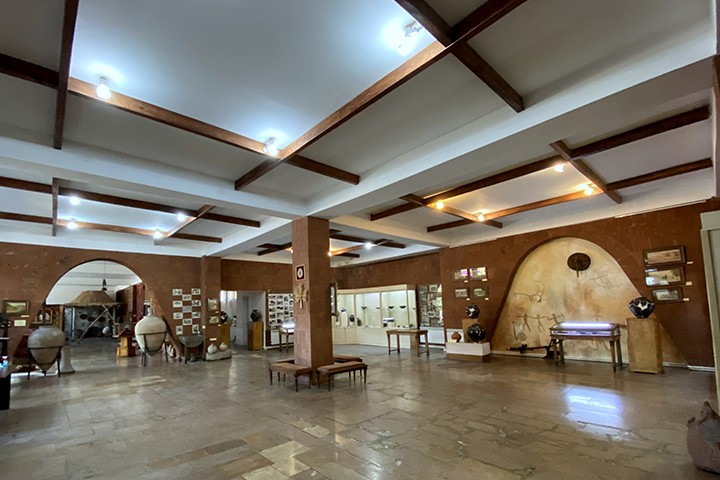ԷՋՄԻԱԾՆԻ ՊԱՏՄԱ-ԱԶԳԱԳՐԱԿԱՆ ԹԱՆԳԱՐԱՆ

Էջմիածնի պատմա-ազգագրական թանգարանը ստեղծվել է 1964թ.: Նրա դահլիճներում և պահոցներում ցուցադրվում և պահպանվում են տասնյակ հազարավոր նմուշներ, հսկայական ազգագրակա նյութ: Սկզբնական շրջանում թագարանի նյութերի համալրումը կատարվել է աշակերտների, ուսանողների և հավաքչական աշխատանքների շնորհիվ:
Հնագիտական պեղումները Էջմիածնի տարածաշրջանում սկսվել էին դեռ 1962թ., որոնք ղեկավարում էր վաստակաշատ հնագետ, պատմական գիտությունների թեկնածու ՀՀ ԳԱԱ Հնագիտության և ազգագրության ինստիտուտի գիտաշխատող Ռաֆիկ Թորոսյանը: Հնագիտական պեղումները Ռ. Թորոսյանի ղեկավարությամբ շարունակվում են մինչև 1985թ.: Հետագայում՝ 90-ականներց մինչ օրս, հայտնաբերված եզակի գտածոները իրենց ուրույն տեղն են գտել պատմա-ազգագրական թանգարանի սրահներում և պահոցներում: Այսօր թանգարանում պահպանվում են շուրջ 15 հազ. ցուցանմուշ, որոնցից մոտ 250 ցուցանմուշ ներկայացնում են ազգագրության բաժինը:
Թանգարանի ցուցադրությունը սկսվում է հնագիտական բաժնից, որտեղ ներկայացվում են Արարատյան դաշտավայրի տեղաբնիկների կենսակերպը, կենցաղը, ապրելակերպը. ժամանակագրությունը սկսվում է էնեոլիթ (պղնձե-քարեդար), վաղ բրոնզե դարից-մինչև միջնադար: Այս ցուցանմուշները լուրջ գիտական արժեք են ներկայացնում: Դրանցից շատերը իրենց բնույթով նույնիսկ եզակի են. նմանատիպ իրեր առկա չեն ոչ Եվրոպայում, ոչ էլ անգամ Առաջավոր Ասիայում: Շատ գիտնականների համար թանգարանի հնագիտական նյութը հանդիսանում է մշտական ուսումնասիրության առարկա: Իսկ ազգագրական հավաքածուն ներառում է Հայաստանի մի շարք շրջաններից, Արցախից, Արևմտյան Հայաստանից բերված ցուցանմուշներ՝ գորգեր, կարպետներ, կենցաղային իրեր, խոհանոցային սպասք, տեղական արհեստներին վերաբերվող նյութեր, հնատիպ գրքեր, լուսանկարներ, կահույք, դրամագիտական հավաքածու և այլն: Ազգագրության սրահում ներկայացված է նաև ավանդական թոնրատան, իսկ հնագիտական սրահում՝ քարեդարյան մարդու կացարանի մոդելները:
Թանգարանում նաև ցուցադրվում է եզակի պատմական ցուցանմուշ՝ տպագրական հաստոց, պատրաստված 1809թ.: Տպագրական հաստոցը Մեծ Բրիտանիայի Վիկտորիա Թագուհին 1894թ. նվիրում է կաթողիկոս Մկրտիչ Ա-ին: Հետագայում տպագրական հաստոցը Մայր Աթոռ Սբ. Էջմիածնից տեղափոխվում է քաղաքային տպարան, իսկ 1970-ական թթ. վերջին Էջմիածնի պատմա-ազգագրական թանգարան, որտեղ մինչ օրս պահպանվում և ցուցադրվում է այս եզակի պատմական ցուցանմուշը: Թանգարանում ցուցադրության հետաքրքիր մաս է կազմում նաև որդան կարմիրը և դրանից ստացված բոլոր երանգների նմուշները:
Անդրադառնալով Էջմիածնի պատմա-ազգագրական թանգարանի բնույթին, ազգագրական և հնագիտական հավաքածոների և նրանց ներկայացման հզոր դերին՝ պետք է նշել, որ այն ազգային ուժ և արժեք է հայ իրական մտածելակերպի համար:
Էջմիածնի պատմա-ազգագրական թանգարանը մշտապես ինքնատիպ նախաձեռնություններով է հանդես գալիս: Այստեղ պարբերաբար անցկացվում են նոր և թեմատիկ ցուցադրություններ: Թանգարանը մշտապես մասնակցում է նաև ՅՈՒՆԵՍԿՕ-ի Եվրոպական ժառանգություն և «Թանգարանների գիշեր» ամենամյա ակցիաներին: